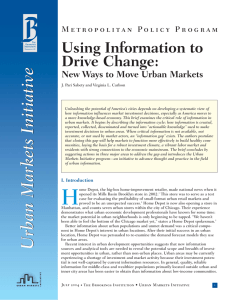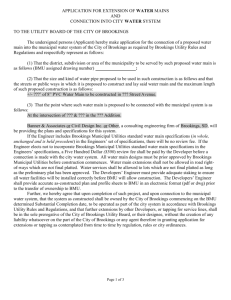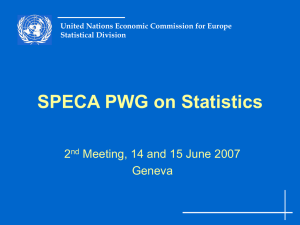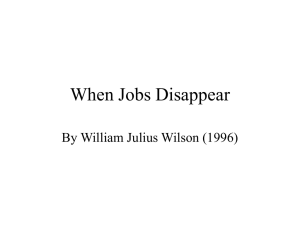- Confronting Suburban Poverty
advertisement
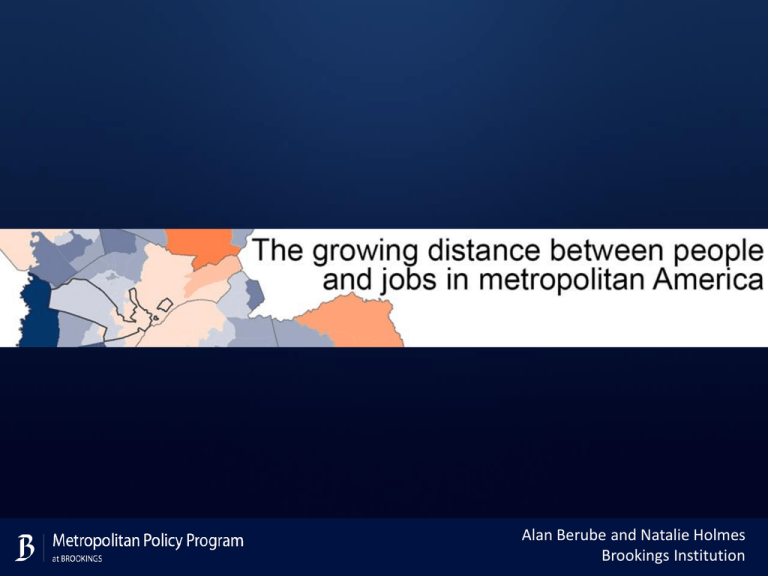
Alan Berube and Natalie Holmes Brookings Institution Purpose of this study • Job locations are shifting within metro areas • Low-income and minority populations are suburbanizing • How have these dynamics changed peoples’ proximity to jobs? • Proximity matters for employment outcomes, access to services, local fiscal health 1 Methods 2 Findings 3 Implications 4 Tools and Next Steps 1 Methods Measuring “nearby” jobs NEARBY JOBS are those located within a typical commute distance of a given census tract (roughly analogous to a neighborhood) TYPICAL COMMUTE is the median “as the crow flies” distance traveled by people living and working in the same metro area AVERAGE NEARBY JOBS, our key metric, is the average number of nearby jobs. We also present averages for different types of residents and neighborhoods. Source: Brookings Institution analysis of Census 2000 data 2 Findings Between 2000 and 2012, the number of jobs near the typical resident fell Source: Brookings Institution analysis of Census 2000 data In most major metro areas, the number of jobs near the average resident shrank in the 2000s Source: Brookings Institution analysis of Census 2000 data The number of jobs near the typical suburban resident fell more than twice as fast as compared to the typical city resident 627,212 605,367 2000 2012 -3.5% 223,365 207,158 -7.3% City Source: Brookings Institution analysis of Census 2000 data Suburb Proximity to jobs is better where job density is higher Source: Brookings Institution analysis of Census 2000 data In many regions, some suburbs gained nearby jobs while others lost nearby jobs Source: Brookings Institution analysis of Census 2000 data The number of high-poverty and majority-minority neighborhoods climbed in the 2000s, especially in the suburbs High-Poverty Neighborhoods 2000 2012 7,674 Majority-Minority Neighborhoods 9,161 8,167 8,111 6,054 5,525 5,539 2,616 City Suburbs Source: Brookings Institution analysis of Census 2000 data City Suburbs These neighborhoods experienced particularly pronounced declines in the number of nearby jobs High-Poverty Neighborhoods Majority-Minority Neighborhoods 738,103 755,897 2000 2012 647,894 664,876 -9.9% -14.3% 292,808 242,911 -15.8% -17.0% City Suburbs Source: Brookings Institution analysis of Census 2000 data 376,490 316,962 City Suburbs 3 Implications These findings demonstrate that… 1. Labor markets are regional but economic opportunity is often dictated by local conditions 2. Strategies to connect low-income and minority residents to economic opportunity must take into account the growing suburbanization of these populations 3. Achieving regional growth that is shared across places and diverse populations will require collaborative solutions Source: Brookings Institution analysis of Census 2000 data 4 Tools and Next Steps Future research topics • The types of jobs near different communities and residents (by wage level, education requirements, and industry) • Commuting patterns within regions • The distribution of affordable housing aberube@brookings.edu nholmes@brookings.edu www.ConfrontingSuburbanPoverty.org



